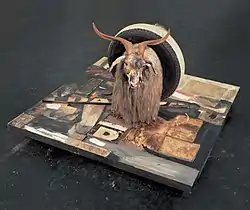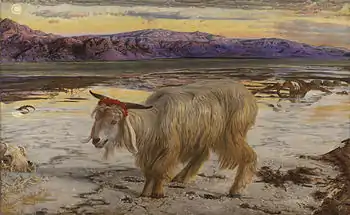Monogram (artwork)
Monogram is a "combine" by American artist Robert Rauschenberg, made during 1955-1959.[1] It consists of a stuffed Angora goat with its midsection passing through an automobile tire.[2] It has been described as Rauschenberg's most famous work.[3] Since its purchase by Pontus Hultén for the Moderna Museet, Stockholm, Sweden, in 1965,[4] it has remained there with occasional world tours.
| Monogram | |
|---|---|
 | |
| Artist | Robert Rauschenberg |
| Year | 1959 |
| Type | oil, paper, fabric, printed paper, printed reproductions, metal, wood, rubber shoe heel, and tennis ball on canvas, with oil and rubber tire on Angora goat on wood platform mounted on four casters |
| Location | Moderna Museet, Stockholm |

History
Rauschenberg created a series of combines between 1954 and 1964, where he merged different aspects of painting and sculpture to create a new artistic category. The artist first saw the stuffed Angora goat in the window of a secondhand furniture store at Seventh Avenue in New York. He took interest in the object and bought it for 15 dollars. Rauschenberg brought it to his studio and would work on this work during the next five years, during which it evolved into three different forms, documented by several studies and photographs, before the final result. The title came from the result of the union of the goat and the tire, which reminded the artist of the letters in a monogram.[5]
Analysis
The work is often taken as what Kenneth Bendiner described as a ‘a specific re-working’ of the Pre-Raphaelite painter William Holman Hunt’s The Scapegoat.[4]
Art critic Catherine Craft said on the work: “Not surprisingly, Monogram shocked contemporary viewers. Still, there is also a strangely poignant beauty to its acquiescent, eternally patient goat. Some observers have associated it with an animal awaiting sacrifice. Nevertheless, with its horns and long, shimmering coat it also recalls the [series of hanging “fetish” assemblages of animal fur, rope, wood and various small objects] Feticci Personali Rauschenberg made in Italy."[6]
References
- Michael Kimmelman (May 14, 2008). "Robert Rauschenberg, American Artist, Dies at 82". The New York Times. Retrieved 14 February 2013.
- "Robert Rauschenberg: A delight in the ordinary". The Australian. News Limited. May 15, 2008. Retrieved 14 February 2013.
- von Uthmann, Jorg (November 8, 2006). "Rauschenberg's Mystery Goat Stars in Paris Show of 'Combines'". Bloomberg L.P. Retrieved 14 February 2013.
- Smith, Graham (2016-10-01). "Rereading Rauschenberg's Monogram". Konsthistorisk Tidskrift/Journal of Art History. 85 (4): 271–298. doi:10.1080/00233609.2016.1201140. ISSN 0023-3609. S2CID 193387235.
- Monogram at the Robert Rauschenberg Foundation Official Website
- The meanings in Robert Rauschenberg's Monogram, Phaidon